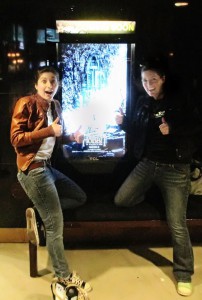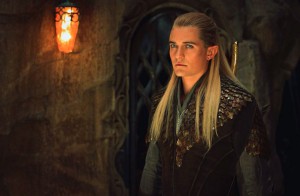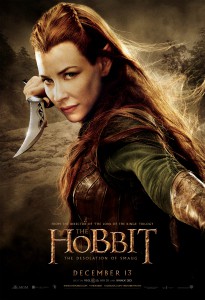
Editor Note: Our second staff review comes from staffer and author, Kili – Yes, half of the Happy Hobbit team. The Happy Hobbits were TheOneRing.net official representatives at the ‘black’ carpet premiere of ‘The Hobbit: The Desolation of Smaug’ this past Monday in Hollywood, CA. (You can see the unedited video coverage in our uStream archive)
As a word of warning, Kili’s review is filled with SPOILERS from the very beginning. If you are avoiding spoilers of any type, please know — you have been warned!
======= SPOILERS START NOW =======
I have never been in more denial of a black screen than I was when Bilbo’s distraught face smashed to darkness. The seconds seemed to crawl by long enough for me to think it was a trick and that more footage was coming, but then the words “Directed by Peter Jackson” appeared on the screen, and the heart-wrenching truth was evident: The Hobbit: The Desolation of Smaug had ended. I am still appalled that I have to wait a year to find out what happens next. None of the Lord of the Rings films ever came close to this type of cliff hanger. It’s like going on a roller coaster then when you reach the top of the biggest hill, you don’t get to go down, and I mean that in the best way possible.
From the moment the film started, I was surprised and delighted by the boldness of the storytelling. I never expected to go back to Bree, much less back in time to when Gandalf first put the idea of the Quest for Erebor in Thorin’s head. This opening scene sets the tone of the film by preparing fans of the book for what is to come: an adventure through Middle-earth that is not limited to the text, but rather revels in exploring new ground.
That isn’t to say that anything from the book is missing. All of the memorable elements of the story are still present, but through the new material, the characters and events are given a depth and beauty that isn’t remotely present in the text. For the first time, we get personal, quiet moments with several characters, adding tension that aids rather than distracts from the quest at hand.
The moment when Bilbo viciously kills an overgrown insect in Mirkwood for even daring to step near the Ring, for example, and Martin Freeman’s brilliant display of Bilbo’s internal struggle afterwards, is mesmerizing. Thus, from the outset it is made clear that Bilbo has already felt the Ring’s power and is a changed hobbit. Legolas, as well, is a different elf than the one we meet in Fellowship of the Ring. This Legolas is cold and arrogant, taking his racism for dwarves to a level that makes it difficult to invest in him, which is the point. After all, this story is ultimately a dwarven epic, and dwarves hold little respect for elves.

Except, it turns out, for one. I didn’t know what to expect from the rumors of Tauriel and Kili having a romance, and was even more unsure about Legolas being thrown into the mix, but the more screen time Kili and Tauriel had together, the more I adored them. The two are opposites in many ways, the most obvious being their races, yet through their conversations, they not only form an attachment to one another, but change each other. When Kili tells Tauriel how he promised his mother to return to her, Tauriel is forced to look beyond any prejudice and see him as a being with hopes and dreams and family. Her admiration for him helps her see through the isolationist ways of King Thranduil, reminding her that she is just as much a part of the changing world around them as the dwarf who has a mother waiting for him.
Despite her youth, Tauriel is the only elf who grasps the importance of her people’s role in the course of the future. While many fans were nervous about her addition, I was overjoyed with the prospect of having a female captain of the Mirkwood guard and applaud the filmmakers and Evangeline Lilly for recognizing the opportunity to add a new layer to the story by bringing unconventional femininity to Middle-earth – a theme Tolkien already established with Éowyn. I grew up pretending I was Indiana Jones and Luke Skywalker because I had no women on screen worth imitating. After all, there are only so many times you can be swung across a pit as Princess Leia. We live in a changed world where heroines are growing bolder and bolder, and Tauriel is no different. The complexity and authenticity of her character speak to everyone, but I am especially excited for children who will grow up with characters like her setting an example and blazing new trails to open minds to what is possible.
Tauriel is a warrior who is cunning and swift and will not hesitate to defend herself, yet she is also kind and nurturing and brave enough to defy her king and prince to do what she knows is right. When she heals Kili, it is an act of compassion that is lost on Legolas, which reveals that, despite what he may feel for her or how many centuries they have had to get to know each other, Legolas does not truly understand Tauriel. His cheap shots at Kili make him sound petty, and it becomes clear that, while a lethal warrior, Legolas is essentially a spoiled prince who I expect we will see start to change in There and Back Again, possibly from Tauriel’s influence. After all, like Éowyn, Tauriel is not a token woman warrior thrown in to appease a modern audience and add sex appeal, but rather is a courageous character whose actions will forever change the course of her world’s history. In contrast to Tauriel’s wisdom, Kili’s fevered idealization of her as his savior makes their friendship and possible budding romance all the more sweet for its innocence, and it could very well be that naiveté that draws Tauriel to the young dwarf.

Similarly touching is Fili’s refusal to leave his brother’s side when Thorin, possibly already feeling the influence of gold sickness, orders his wounded nephew to stay behind with little regard to his well-being. In fact, I would have loved to see more of their brotherly bond reinforced amidst Kili’s growing affection for Tauriel. I am hoping that there will be more of Fili coping with his responsibility as heir either in the extended edition or the following film, because by staying behind he directly disobeys his uncle and king, marking him as an upstart as much as Tauriel (and Bard). Apparently Laketown breeds rebelliousness! But maybe my investment in their sibling bond is skewed because of my sister being nicknamed Fili to my Kili (which is basically Kellie!)
While both of Tolkien’s most famous works center around hobbits, a major difference between Lord of the Rings and The Hobbit is the presence of mankind. Aragorn’s journey to the throne becomes nearly as dear to the viewers as Frodo’s quest to destroy the Ring, and the realms of Men that we visit along the way remind us that Mankind is second only to hobbits as the heart and soul of the tale. In Lord of the Rings, Legolas and Gimli’s races are treated like fun oddities to contrast Aragorn, but if anything, the opposite is now true for The Hobbit. The first human character we meet (outside of people in the background) is Bard the Bowman, and for once, after spending so much time with dwarves and elves, the human feels like the peculiar oddity, which is a fun shift in perspective.
That being said, I love how so much of the new material focuses on the richness these different cultures and races bring to one another. As far as we know, The Hobbit films will be our last cinematic journey to Middle-earth, and I for one am happy to explore as many aspects of Arda’s wide and varied world as possible. For example, the way the humans react to Thorin and his Company of dwarves arriving in Laketown is fascinating, for they favor him over Bard, their kindred. The touching musical piece that accompanies Kili and Tauriel’s theme, written by Philippa Boyens, is a mixture of Elvish and Dwarvish. And of course, we have Smaug the dragon interacting with a hobbit for the very first time, which is a true delight.
While some Tolkien fans may balk at any deviations from the original work, I have never grasped the benefit of such a limited perspective. No one is changing the text, and as a writer, I seek to make a connection with people. Once a book is shared, it is no longer solely my own, but rather belongs to everyone who invests in it, and each reader has a unique interpretation. I would love to see one of my stories retold visually, changes and all, so long as its heart and spine remain true. Bad book adaptations always make fans defensive because we don’t want the characters and world we so love to be misrepresented to the masses, yet that is far from the case here. Philippa Boyens, Fran Walsh, and Peter Jackson have already proven themselves worthy of the task of adapting Tolkien and do so again in this film. I prefer this expanded plot because despite what I may have read in the book, and while I ultimately know where the story will end, I delight in the new twists and turns along the way.
The Desolation of Smaug has all of the memorable elements of the book and more, providing ample opportunity for emotional attachment to the characters as we get to know them better. Like An Unexpected Journey, we are left feeling as if we have gone on the adventure along with Bilbo and the dwarves, and it is one fun, wild barrel ride! Tauriel is a rich, catalytic addition, and I can’t wait to see what happens next. I am still trying to tell myself that a year isn’t so long to wait, after all, but who am I kidding?! In the meantime, I will content myself with the feast of starlight that is Jackson and his team’s vision of an expanded Middle-earth.


